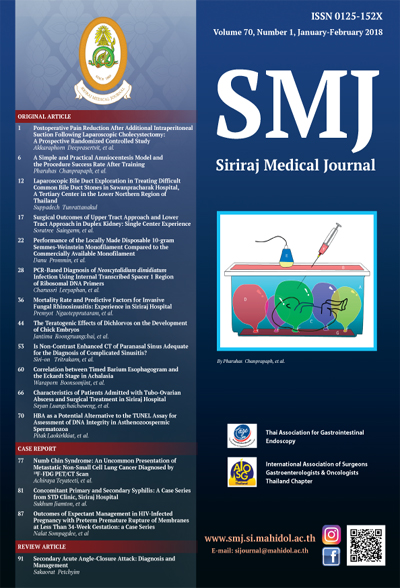Correlation between Timed Barium Esophagogram and the Eckardt Stage in Achalasia
Keywords:
Timed barium esophagogram; Eckardt stage; achalasiaAbstract
Objective: To evaluate the correlation of timed barium esophagogram (TBE) parameters and the Eckardt stage in patients with achalasia.
Methods: This prospective study was done in 29 adult achalasia patients who underwent TBE and were assessed for clinical symptoms according to the Eckardt stage. The association between the Eckardt stage and TBE parameters including the height and the width of barium column, esophageal emptying between 1 and 5 minutes was calculated by comparing the area of barium column and esophageal emptying between 0 and 5 minutes, which was calculated from the relative changes in ingested volume to estimated volume of barium column on the 5-min image and this was calculated by using Kruskal-Wallis test. Comparison of mean emptied volume at 1 min. image and mean emptied volume between 1 and 5 minutes was done by using paired samples t-tests.
Results:There was a significant difference in the amount of emptied volume at 1 min image (mean = 118.27, SD = 31.1) and emptied volume between 1 min and 5 min images (mean = 11.41, SD = 9.4); t(27) =15.375, p < 0.001. Statistically significant difference in esophageal emptying between 1 and 5 minutes across the Eckardt stages was found (H=8.115, 3 d.f., p=0.044). The difference was statistically significant between the Eckardt stage 2 and 3 (p=0.039). There were no statistically significant differences in other TBE parameters across the Eckardt stages.
Conclusion:No statistically significant difference in TBE parameters across the Eckardt stages was found in the present study. However, TBE is a useful objective method to assess esophageal emptying in patients with achalasia. Interpretation of TBE should be standardized. Calculation of esophageal emptying should include the amount of barium emptied from the esophagus in the first minute.
Downloads
Published
How to Cite
Issue
Section
License
Authors who publish with this journal agree to the following conditions:
Copyright Transfer
In submitting a manuscript, the authors acknowledge that the work will become the copyrighted property of Siriraj Medical Journal upon publication.
License
Articles are licensed under a Creative Commons Attribution-NonCommercial-NoDerivatives 4.0 International License (CC BY-NC-ND 4.0). This license allows for the sharing of the work for non-commercial purposes with proper attribution to the authors and the journal. However, it does not permit modifications or the creation of derivative works.
Sharing and Access
Authors are encouraged to share their article on their personal or institutional websites and through other non-commercial platforms. Doing so can increase readership and citations.











